What Damages Can You Seek In A Snapchat Lawsuit?
- Last Updated: June 12th, 2025

Attorney Jessie Paluch, founder of TruLaw, has over 25 years of experience as a personal injury and mass tort attorney, and previously worked as an international tax attorney at Deloitte. Jessie collaborates with attorneys nationwide — enabling her to share reliable, up-to-date legal information with our readers.
Legally Reviewed
This article has been written and reviewed for legal accuracy and clarity by the team of writers and legal experts at TruLawsuit Info and is as accurate as possible. This content should not be taken as legal advice from an attorney. If you would like to learn more about our owner and experienced injury lawyer, Jessie Paluch, you can do so here.
Fact-Checked
TruLawsuit Info does everything possible to make sure the information in this article is up to date and accurate. If you need specific legal advice about your case, contact our team by using the chat on the bottom of this page. This article should not be taken as advice from an attorney.
Key Takeaways:
- Victims pursuing a Snapchat lawsuit can seek economic damages for financial losses such as medical bills, lost wages, and non-economic damages for emotional distress and pain.
- In some cases, plaintiffs may be eligible for punitive damages if they prove Snapchat's conduct was extremely negligent or malicious, aiming to punish the company and prevent future wrongdoing.
- It is critical to thoroughly document all evidence of harm, including medical records, expert testimonies, and witness statements, to build a strong case demonstrating the extent of damages suffered.
Overview of the Snapchat Lawsuit
On this page, we’ll discuss an overview of the damages you can seek in a Snapchat lawsuit, precedence-setting case studies of the Snapchat lawsuit, submitting a Snapchat mental health claim, and much more.
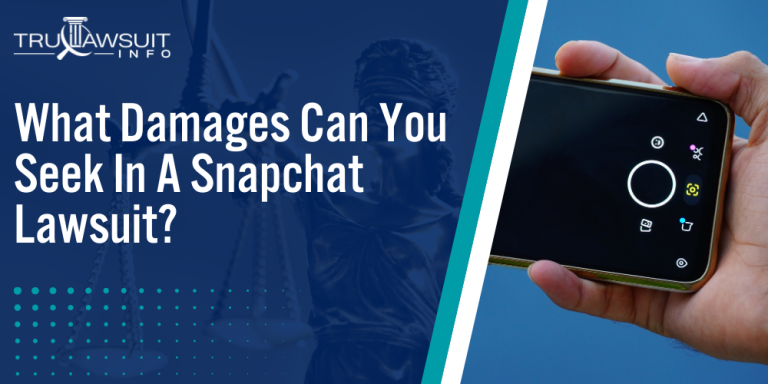
Intro to the Snapchat Lawsuit
The Snapchat lawsuit alleges the use of facial recognition technology violates privacy laws amongst other various legal challenges.
Here are some specific focal points within the case:
- The involvement of a California judge indicates the lawsuit’s jurisdiction and potential implications for tech companies based in California.
- The Communications Decency Act often shields online service providers but is facing increasing scrutiny concerning user privacy.
- The federal judge’s decision could set a precedent for how social media companies are regulated and held accountable.
- The lawsuit’s central issue is the allegation of unauthorized use of facial recognition technology, which raises profound concerns about user consent.
If Snapchat’s features have caused harm, you may be eligible to seek compensation for your damages.
Contact TruLawsuit Info using the chat on this page to discover if you qualify to file a Snapchat lawsuit today.
Table of Contents
Types of Damages in Snapchat Lawsuits
When pursuing a Snapchat lawsuit, plaintiffs may seek various forms of damages, each relating to specific alleged harms from the use of social media apps, including wrongful death and personal injury, mental health impacts, public nuisances, and violation of anti-drug policies.
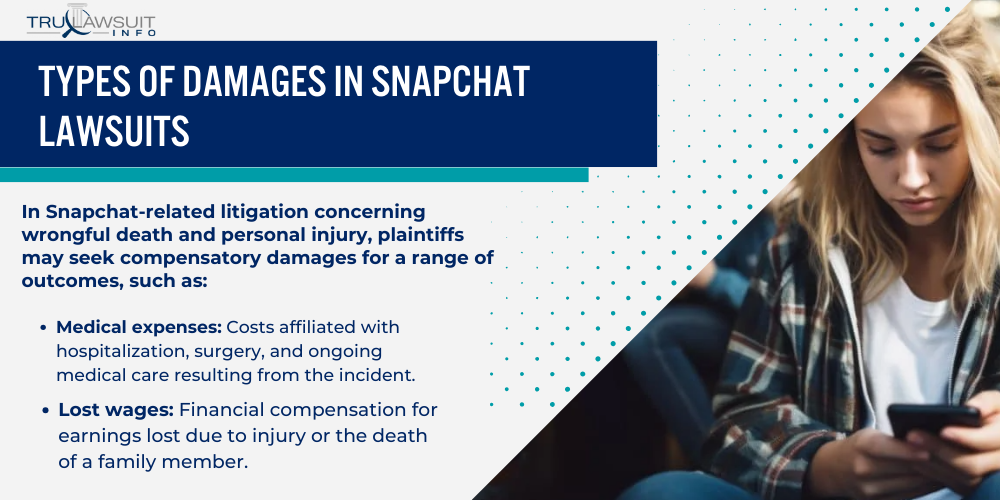
Wrongful Death and Personal Injury
Litigation involving Snapchat and similar platforms in cases of wrongful death and personal injury focuses on securing compensation for victims and their families.
Plaintiffs often seek damages for immediate medical costs and long-term emotional and financial impacts.
In Snapchat-related litigation concerning wrongful death and personal injury, plaintiffs may seek compensatory damages for a range of outcomes, such as:
- Medical expenses: Costs affiliated with hospitalization, surgery, and ongoing medical care resulting from the incident.
- Lost wages: Financial compensation for earnings lost due to injury or the death of a family member.
- Pain and suffering: Remuneration for the physical pain and emotional trauma endured as a result of the injury or death.
- Loss of consortium: Damages claimed by the spouse or family members for the loss of companionship due to the wrongful death or injury.
Mental Health Implications
Mental health concerns, particularly among youth, can lead to compensation for damages linked to the platform’s alleged role in a youth mental health crisis.
Damages in this domain often include:
- Costs of psychological treatment for conditions attributed to Snapchat use.
- Compensation for emotional distress suffered by plaintiffs.
- Damages for reduced quality of life due to mental health struggles.
- Educational or occupational setbacks attributed to the platform’s impact.
Public Nuisance
Allegations of public nuisance typically pertain to the app’s role in facilitating harmful behaviors that affect communities.
Claims may cover:
- Reduction in property values: Impact on residents’ property values due to the nuisance created.
- Costs for additional policing and public safety measures: Financial implications for local governments and taxpayers.
- Impact on community health: Widespread effects on the health of community members.
- Administrative expenses for dealing with the nuisance: Resources allocated by authorities to combat the issues caused.
Violation of Anti-Drug Policies
Claims regarding violations of anti-drug policies focus on Snapchat’s alleged facilitation of drug dealers’ activity, including in cases where individuals have allegedly suffered fentanyl overdoses.
Plaintiffs may seek damages such as:
- Costs related to law enforcement actions: Expenses incurred in combating drug sellers posted content on the platform.
- Prevention and education programs: Funding for initiatives aimed at preventing drug abuse and educating the public.
- Treatment and rehabilitation expenses: For individuals adversely affected by drug activities linked to Snapchat.
- Civil penalties: As laid down by anti-drug statutes to discourage the platform from allowing such activities.
Case Studies and Precedents of the Snapchat Lawsuit
The litigation involving Snapchat has set significant precedents in the realm of social media lawsuits, with disputes often focusing on tech company accountability, the role of third-party drug dealers, and the effectiveness of content moderation.
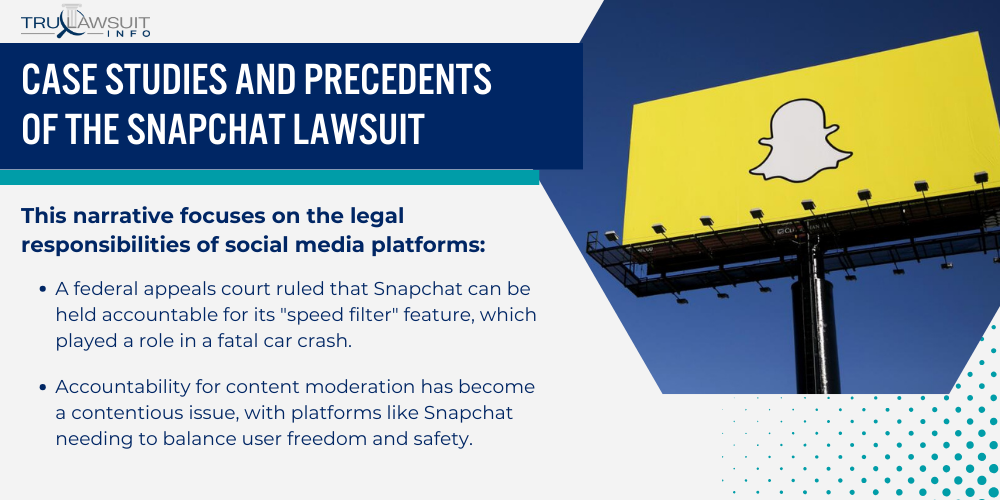
Content Moderation and Tech Company Accountability
Snapchat has faced legal scrutiny amidst growing concern over whether tech companies are doing enough to nip content moderation suits in the bud.
One focal point is the platform’s duty to protect users from harm resulting from its features.
This narrative focuses on the legal responsibilities of social media platforms:
- A federal appeals court ruled that Snapchat can be held accountable for its “speed filter” feature, which played a role in a fatal car crash.
- Accountability for content moderation has become a contentious issue, with platforms like Snapchat needing to balance user freedom and safety.
- Lawsuits have prompted changes in policies and features to enhance user protection.
- Other platforms are watching Snapchat closely, as outcomes could set a precedent impacting the entire social media industry.
Claims Against Third-Party Drug Dealers
Third-party drug dealers using Snapchat to sell illegal substances have led to claims being filed by victims’ families, asserting that the social media company failed to monitor and prevent such activities adequately.
Identifying the involvement of Snapchat in drug-related incidents includes several considerations:
- The role of Snapchat in facilitating the sale of illegal drugs, especially regarding fentanyl overdoses.
- Actions by Snapchat to combat the presence of drug dealers on the platform.
- Multiple families have filed similar claims, challenging the platform’s vigilance against such misuse.
- The outcome of these cases may pressure social media companies to enforce stricter content moderation policies.
Meta Platforms Case Analysis
The analysis and outcomes of Meta Platforms litigation offer insights into the evolving legal environment in which tech companies like Snapchat operate, especially regarding social media lawsuits.
Key aspects from Meta Platforms litigation could inform Snapchat’s legal strategy:
- The number of a dozen claims and similar claims filed against Meta illustrates the broad range of issues users have taken to court.
- The similarities and differences between Meta and Snapchat’s cases could be instructive for both plaintiffs and defendants.
- Court decisions have indicated the level of responsibility tech companies may bear for user-generated content and behavior on their platforms.
- The trend towards holding social media platforms accountable suggests a potentially tighter regulatory future for the industry.
Snapchat Lawsuit: Plaintiffs and Defendants
The Snapchat Lawsuit has engaged a diverse field of participants, ranging from family members mourning personal losses to a social media giant defending its technology and policies.
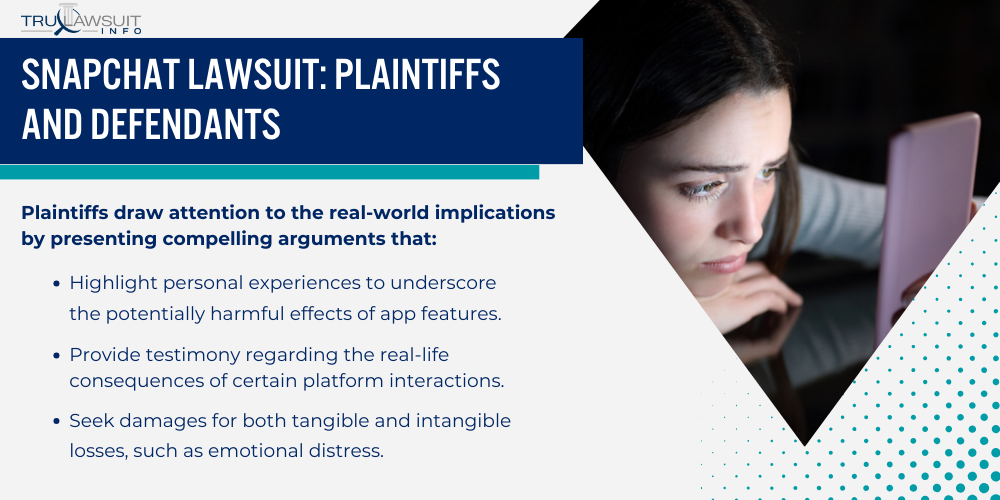
Role of Family Members and Victims
Family members and victims play a crucial role in Snapchat lawsuits by providing firsthand accounts of the impact that the platform’s features may have had.
They often:
- Highlight personal experiences to underscore the potentially harmful effects of app features.
- Provide testimony regarding the real-life consequences of certain platform interactions.
- Seek damages for both tangible and intangible losses, such as emotional distress.
- Push for changes in the platform’s policies to prevent future harm to individual internet users.
Defensive Strategies by Social Media Companies
In response to lawsuits and allegations, social media companies such as Snapchat often adopt a range of legal and technical defenses to counter claims about their platform’s impact on users.
These strategies typically involve challenging the causation between the platform’s features and alleged damages and emphasizing the role of user agency and free speech in digital spaces.
Social media companies, like Snapchat, implement a variety of defensive strategies to fight allegations:
- Refute claims that the platform’s design directly contributes to specific damages.
- Argue for the protection of free speech on the internet, positing that content is user-generated.
- Stress voluntary user engagement with features, underlining the personal choice in app use.
- Present expert analyses claiming service offerings are not factually flawed or harmful.
Snapchat's Protective Measures and Parental Controls
Snapchat has initiated several steps to safeguard users, with a particular focus on teens.
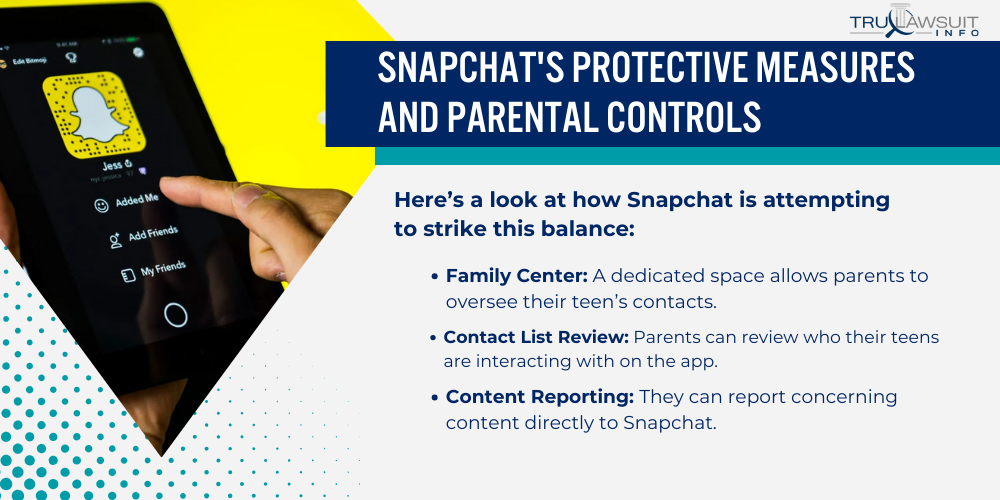
Their platform has integrated effective parental controls and enhanced content moderation efforts, all while navigating the complexities of the Communications Decency Act.
Implementing Effective Parental Controls
Snapchat acknowledges the importance of empowering parents to protect their teens on social media platforms.
They have implement effective parental controls that are designed to function without infringing on teens’ privacy.
Here’s a look at how Snapchat is attempting to strike this balance:
- Family Center: A dedicated space allows parents to oversee their teen’s contacts.
- Contact List Review: Parents can review who their teens are interacting with on the app.
- Content Reporting: They can report concerning content directly to Snapchat.
- Snapchat’s Safety Features: Include tools to help prevent contact with unknown users or drug dealers.
Push for Better Content Moderation
Continuous efforts to improve content moderation are central to Snapchat’s strategy in creating a safer environment.
The specific measures they’ve adopted include:
- Improved Algorithms: These are designed to filter out harmful content.
- Human Review Teams: Staff members who oversee content and user reports.
- Sensitive Content Filter: A recent update to block inappropriate content for minors.
- User Education: Initiatives to inform users of the tools available for their safety.
Communications Decency Act and Its Impact
The Communications Decency Act, particularly Section 230, provides platforms like Snapchat with immunity from liability for user-generated content.
However, they still maintain a proactive stance:
- Transparency Reports: Snapchat releases data on their compliance with law enforcement.
- Legal Boundaries: They navigate the thin line between user safety and privacy.
- Policy Enforcement: Actively enforce policies that go against their Community Guidelines.
- Partnership with Experts: Collaborate with safety experts to enhance their protective measures.
Impact on Youth and Society: Snapchat Lawsuit
Snapchat lawsuits underline serious concerns regarding social media’s effect on young users and highlight the potential for harm.
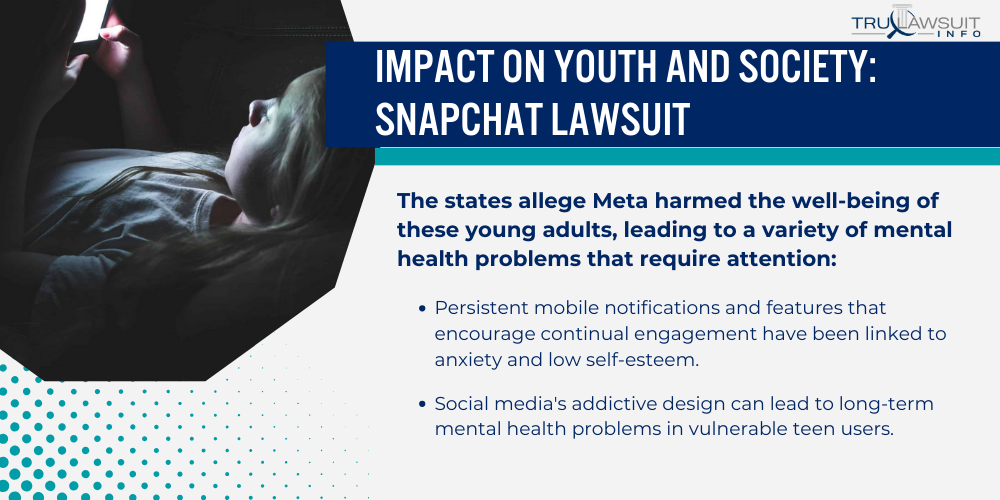
Influence on Young Users and Mental Health
Snapchat and other social media companies have been at the center of scrutiny for their influence on teen users.
The states allege Meta harmed the well-being of these young adults, leading to a variety of mental health problems that require attention:
- Persistent mobile notifications and features that encourage continual engagement have been linked to anxiety and low self-esteem.
- Social media’s addictive design can lead to long-term mental health problems in vulnerable teen users.
- The comparison culture perpetuated through Snapchat Stories and filters can diminish young people’s self-esteem.
- States allege that Snapchat and other social media platforms have not done enough to protect the mental health of young people, particularly children allegedly exploited by these persuasive technology designs.
Social Media and Substance Abuse
The connection between social media and substance abuse is a critical concern, specifically regarding the exposure of young adults to harmful content.
Six key points about Snapchat and substance abuse are:
- Exposure to images and stories promoting substance use can trivialize the risks associated with drugs.
- The platform has, in some instances, been used to facilitate illegal drug sales, as seen in instances where Snapchat has been linked to fentanyl distribution.
- The app’s disappearing messages can hinder parental monitoring and law enforcement intervention.
- Young adults may imitate risky behaviors showcased on Snapchat, increasing the danger of substance abuse.
Persistent Negative Effects on Self-Esteem
Snapchat’s influence does not stop at fleeting interactions but can embed lasting detrimental effects on its users’ perception of themselves, particularly on young adults and teen users.
Consider the following points for a deeper understanding:
- The emphasis on image-centric communication on Snapchat amplifies concerns about appearance and can lead to sustained low self-esteem.
- Highlighted visual distortions from filters can create unrealistic beauty standards.
- Persistent mobile notifications from the app can make teen users feel pressured to engage continuously, affecting their self-worth.
- Fear of missing out (FOMO), powered by real-time updates, can make young people feel isolated and insufficient.
Legal Resources and Support in the Snapchat Lawsuits
Individuals seeking compensation in Snapchat lawsuits may have diverse legal options and support systems.
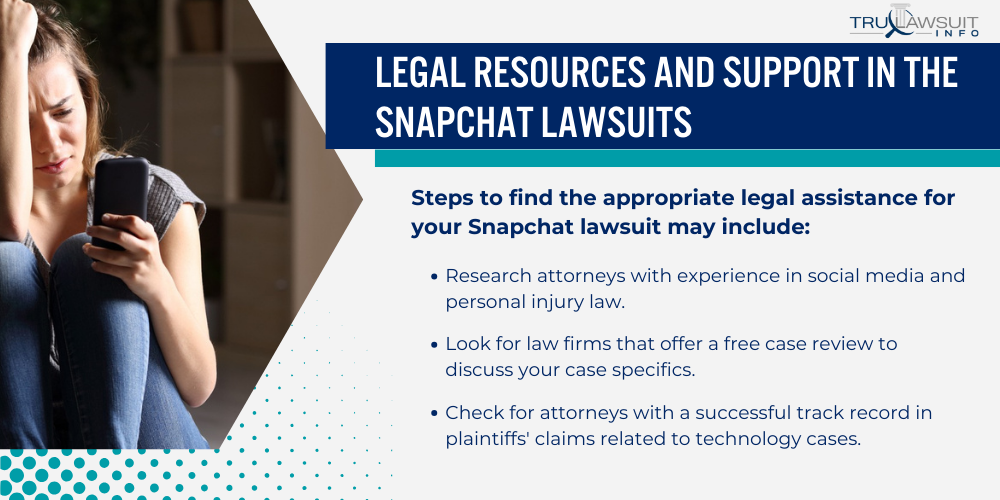
These lawsuits often pertain to product and business decisions that claimants allege led to dozen claims or damages, some of which tragically proved fatal.
Finding Legal Assistance
For those affected by Snapchat’s allegedly harmful ways, finding qualified legal assistance is crucial.
Steps to find appropriate legal assistance include:
- Research attorneys with experience in social media and personal injury law.
- Look for law firms that offer a free case review to discuss your case specifics.
- Check for attorneys with a successful track record in plaintiffs’ claims related to technology cases.
- Consider firms that actively investigate violations of consumer protection or personal injury laws.
Media Victims Law Center Involvement
The Media Victims Law Center has been a pivotal advocate for families impacted by social media platforms.
To understand their role:
- They provide resources and support for family plaintiffs dealing with losses.
- Their involvement often includes a comprehensive evaluation of the case’s merits.
- The center is an advocate for those affected by social media’s impacts on mental health.
- They are a gathering point for shared experiences and push for accountability in such cases.
California State Judge’s Influence
A California state judge’s rulings can significantly impact the outcome and expose social media platforms to even more lawsuits.
Points of influence include:
- Deciding whether the evidence presented supports the plaintiffs’ cases against Snapchat’s use practices.
- Interpreting state laws around digital product liability.
- Directing how discovery should proceed, especially with regard to business decisions and their impacts.
- Determining if cases have enough in common to be certified as a class action, potentially involving multiple family plaintiffs.
Frequently Asked Questions
-
What types of compensation might be available to claimants in a Snapchat legal settlement?
Claimants in a Snapchat legal settlement may be eligible for various forms of compensation.
These can encompass economic damages, covering actual financial losses, and non-economic damages, which refer to non-monetary detriments.
Some compensation might also address punitive damages intended to punish the defendant for particularly harmful behavior.
-
How can an individual initiate a lawsuit against Snapchat?
To begin a lawsuit against Snapchat, an individual needs first to establish a legal basis for their claim that Snapchat’s actions have caused them harm.
Then they must file an official complaint in a court with appropriate jurisdiction.
Legal representation can greatly aid this process, ensuring that the proper procedures are followed and that the claimant’s rights are adequately protected.
-
What updates are there regarding the progress of ongoing Snapchat litigation?
For recent events and developments in ongoing Snapchat litigation, claimants should look for official court records or reliable legal news sources.
Tracking the progress of related cases can provide insight into how similar lawsuits may unfold.
Transparency from the involved legal teams often provides updates through press releases or official statements.
-
Are there precedents of individuals successfully suing Snapchat, and what were the outcomes?
Several cases have set precedents in litigation against Snapchat, with mixed outcomes.
Some plaintiffs have received settlements—like the Illinois facial recognition lawsuit—while others have led to dismissals or ongoing disputes.
The specifics of each case greatly influence the outcome and the type of damages awarded.

Experienced Attorney & Legal SaaS CEO
With over 25 years of legal experience, Jessie is an Illinois lawyer, a CPA, and a mother of three. She spent the first decade of her career working as an international tax attorney at Deloitte.
In 2009, Jessie co-founded her own law firm with her husband – which has scaled to over 30 employees since its conception.
In 2016, Jessie founded TruLaw, which allows her to collaborate with attorneys and legal experts across the United States on a daily basis. This hypervaluable network of experts is what enables her to share reliable legal information with her readers!
Have A Case?
Here, at Tru Lawsuit Info, we’re committed to helping victims get the justice they deserve.
To do this, we actively work to connect them with attorneys who are experts in litigating cases similar to theirs.
Would you like our help?
Tru Lawsuit Info is a reliable source of information about issues that may affect your health and safety, such as faulty products, data breaches, and environmental hazards.
Our team of experienced writers collaborates with medical professionals, lawyers, and advocates to produce informative articles, guides, and other resources that raise awareness of these topics.
Our thorough research provides consumers with access to reliable information and updates on lawsuits happening around the country. We also can connect consumers with attorneys if they need assistance.
Camp Lejeune's water contamination issue spanned several decades starting in the 1950s. Exposure to these chemicals has been linked to various serious health issues, including cancer, organ diseases, and death.
Research is increasingly suggesting a link between the use of Tylenol during pregnancy and the development of neurodevelopmental disorders, such as autism and ADHD, in infants.
Legal action is being taken against manufacturers of Aqueous Film-Forming Foam (AFFF), a chemical used in fighting fires. The plaintiffs allege that exposure to the foam caused health issues such as cancer, organ damage, and birth and fertility issues.
Have A Case?
Here, at Tru Lawsuit Info, we’re committed to helping victims get the justice they deserve.
To do this, we actively work to connect them with attorneys who are experts in litigating cases similar to theirs.
Would you like our help?







